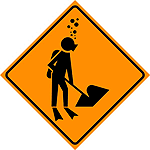|
| |

|
|
| < Prev. month |
Next month > |

|
This page under construction.
Here are some of the topics that will be covered in this chapter. More text and images will eventually be added to this section. Thank you for your patience.
|
- During winter storms, intertidal animals and algae face significant challenges from large waves, strong currents, battering by storm debris, and sand scour.
Strong southerly winds during winter storms generate strong northerly currents within a few miles of the coast. Meanwhile, in the surf zone and kelp beds, huge northwest swells can generate strong currents to the southeast.
- Extreme high tides around the time of the winter solstice may be augmented by temporary sea level rise of a foot or more caused by lowered atmospheric pressure during winter storms. In addition, short-term rises in sea level may be caused by "set up" during periods of especially large winter waves. The net result is that the ocean reaches higher up onto the land in winter than at any other time of year.
- Large winter storm waves can strip sand from beaches in a matter of hours. This sand may be deposited in the kelp beds or form extensive sand bars hundreds of yards offshore (sometimes burying attached algae and animals in the kelp beds). In the intertidal zone, this process exposes bare rocks, and scours rock surfaces. However, in an environment where bare rock surfaces and living space are at a premium, all this disruption creates opportunities for other animals and algae to colonize bare areas.
- Within a few weeks of being exposed by sand removal, bare rock surfaces in the intertidal begin to be colonized first by (extremely slippery) diatom films, and then by fast-growing green algae such as Ulva and Enteromorpha. Bare rock areas that remain exposed (unburied) for a month or more may be colonized by "weedy" species of red and brown algae, including Mastocarpus papillatus, Pelvetia fastigata, Mazzaella jardinii, and Mazzaella splendens.
- Wide, flat rock platforms exposed by sand removal may be colonized by filamentous red algae such as Gracilariopsis. From their hiding places in hairline cracks in the rock, Gracilariopsis spores sprout and grow rapidly over the rock surface that has been swept clear of sand. Like surf grass, they are quite tolerant of being buried in sand, and may even grow better when their bases are protected from scour by an inch or two of sand. By summer, the Gracilariopsis may disappear again.
- Many annual brown algae (e.g. Pelogophycus, Nereocystis, Costaria, Cymathere tripicata, and Alaria nana) release spores in late fall. These spores settle in tiny cracks and crevices in intertidal or subtidal rocks, where they somehow survive the winter storms, to sprout in spring, when light and nutrients increase.
- Surf grass seeds ripen and are dispersed by winter wave action, often latching onto coralline red algae or filamentous red algae, which are exposed and lush in winter.
- Tunicates and some sponges die back or are torn off by winter storms, often leaving behind a thin film of living tissue, which will regrow in spring. Similarly, many brown algae die back, leaving just a rounded stump or flat patch on the rock, from which new sprouts will regrow rapidly in spring. These strategies allow the animals and algae to save their places on the rock through the winter season.
- Other algae, such as feather boa kelp and Laminaria, shed most or all of their blades during winter, but maintain short stipes and strong holdfasts throughout the winter months.
- Some mobile animals move from the intertidal zone out into the kelp beds (just as kelp-bed animals are heading farther offshore). Others, such as sea stars, hunker down in rock crevices for weeks at a time, only coming out to feed only during calm periods.
- Rock crabs and purple shore crabs carry eggs all winter, despite all the storms.
- A number of hardy intertidal animals (including some predatory snails, chitons, limpets, periwinkles, and tar-spot sea cucumbers) spawn in the middle of winter.
- Periwinkles colonize sand-scoured rocks, and sometimes become more abundant in winter, when they feed on diatom films, Ulva, and other soft-bodied algae. Periwinkles also lay eggs in the winter months. After the eggs hatch, the larvae crawl around on the rocks for a week or so before turning into young snails (CHECK THIS).
- Like periwinkles, ribbed limpets (Collisella digitalis) feed on diatom films and spawn in winter, especially when the waves are rough and seawater salinity is low (e.g. due to runoff). Their larvae drift at the mercy of winter storm waves and currents, which may keep them relatively close to shore.
- Other intertidal molluscs, including white-cap limpets, a few chitons (Mopalia hindsii and Lepidozona californiensis) spawn in winter. Some predatory snails (Thais and Nucella spp.) may also lay eggs at this time of year, although the literature is not consistent on this.
- Tar-spot sea cucumbers brood eggs in December, carrying the eggs around for about a month before the eggs hatch, releasing young sea cucumbers. Both adults and young tar-spot sea cucumbers live on corraline red algae, and feed on diatom films, both of which are relatively abundant in winter.

|
|
